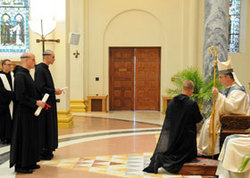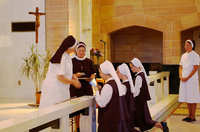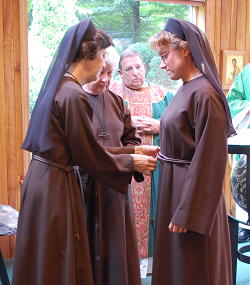Spring and summer great times in abbeys and great orders because of the ordinations, profession of vows, entrances to the novitiate and the anticipation of such things. God, indeed, provides…God hears our prayers for humble workers in the vineyards. We seek the face of God together, in faith, hope and charity.
For last two years I’ve been compiling a selective list of orders that have received new members and noting which ones had professions of vows because I was awe struck by the fact that some people are still being called to do such. That is to say, I am not struck by the fact that God still calls men and women to accept the gift of religious life but that they actually say ‘yes’ to the Divine Invitation to follow Him.
I was also curious to know which groups, randomly surveyed, got new members. Leading others to Christ is serious business, so I wanted to know how the Church in America might fare in the future with fewer vocations. For example, the tri-provinces of the Eastern Jesuits (the Provinces of Maryland, New England & New York) admitted only 8 for themselves for 2010. To compare numbers, in the New England Province in 1990, 6 men entered the Jesuit society (only 1 remains today) and in 2010 they admitted only 2 men. Dismal numbers given the beauty of the vocation. What would Saint Ignatius of Loyola say?????
Let us note well: Some religious orders or monasteries don’t want anyone to know the facts of professions, entrants or ordinations too readily. This is frustrating because the info should be readily available if a group has a website. There is good reason to believe that many religious are embarrassed by the fact that no one is entering or that with all the money being spent on vocation promotion no one is interested in their way of life as it is lived in that group’s context. Moreover, some orders are not aware of the value of internet technology in today’s era, or are just incapable of find the “right way” to use technology to assist in getting the word out there that life exists in their order or that the charism they’re living is worth living and may be attractive to others.
We should acknowledge the fact that some orders are dying (or are already dead and the membership is refusing to admit that their group is dead) but if God has given the grace to come into existence, to abort the charism/vocation too readily and without taking stock in the factors that have contributed to diminishment and the factors of correctives, is perplexing.
Nothing beats being faithful to some simple facts which encourages a faithful living of the vowed life and makes it attractive to others:
- a common prayer life and personal prayer which includes Mass, the Divine Office, Adoration of the Blessed Sacrament, Lectio Divina, the rosary; a daily hour could be optional but there ought to be a good reason why a religious is not making a holy hour more often than not;
- a common vision for living and serving the gospel in the Catholic Church as it is today, not as the Church “was in the 1970s, 1980s, 1990s” or what the Church “should be”; the work done together, whether serving the poor, teaching school, being chaplains needs to cohere to the founding charism, be done together, and with joy in the Risen Lord; serving the gospel and the Church means being faithful to the Church’s teaching authority, which means pastoral authority of the Pope and the bishops;
- a caring fraternal life
- the wearing of a religious habit not only in the house but in public; if you won’t wear the habit in a restaurant or movie theater or any other place, including the airport, then you shouldn’t be there; the wearing of the roman collar for religious orders should be done by exception if there is a legitimate habit available and the lapel pin just doesn’t cut it.
In sum, I’d say that a religious ought to live the virtues we observe in God’s Trinitarian life: be familial/communal with to regard to living, faithfully accepting of another’s differences (the gifts the other brings), maintaining a personal dependence on another realizing that we humans didn’t make ourselves and we really only know ourselves in light the other person, having an attitude for the sharing of resources and the practice of hospitality remembering that we receive guests as though it was Christ Himself knocking on our door.
The fruit of prayer and witness to Christ is seen in the admission of candidates to religious life as postulants, novices, simply and solemnly professed members as well as ordinations. Let me give you a sampling of what I am talking about –this is not a comprehensive list:
The Monastic Life:
Monastero di Bose (Italy) solemnly professed three, 1 monk and 2 nuns.

Saint Walburga Abbey (Virginia Dale, CO) have 3 novices, 1 sister professed simple vows and there are 5 sisters in temporary vows. The abbey has a blog.
Saint Emma Monastery (Greensburg, PA) has 1 novice.
Benedictines of Mary, Queen of Apostles (Kansas City-St Joseph, MO) have regular vocations but as to numbers, that is unknown. You would have to wait for their newsletter or call them.
Abbey of St Paul outside the Walls (Rome) simply professed 1 and there are 2 novices.
St Louis Abbey solemnly professed 2 monks, will simply profess 1 and admitted 1 to the postulancy and ordained another to the priesthood in June. Father Bede reports that in the past 13 months there have been a total of 5 solemn professions and D.V. there will be 1 simple profession in November and a solemn profession in January 2011.
St Anselm’s Abbey (Washington, DC) simply professed 1 monk.
Marmion Abbey solemnly professed 1 monk and admitted 2 to the novitiate.
St John’s Abbey 2 monks made solemn vows and 4 simply professed vows; their stories are here; 2 were admitted to the community.
St Mary’s Abbey (Morristown, NJ) simply professed 2 monks on May 1. Four entered the novitiate.
St Vincent’s Archabbey ordained 1 to the priesthood, 5 became novices and 4 professed simple vows. The juniorate has 13 monks.
St Meinrad Archabbey ordained 1 priest and 2 professed solemn vows.
St Benedict’s Abbey (in Kansas) ordained 2 monks, 1 to the order of deacon and another to the priesthood.
St Benedict’s Abbey (in Wisconsin) simply professed 1.
Conception Abbey simply professed 1, solemnly professed 1 and 4 entered the novitiate.
The Monastery of San Benedetto (Norcia, Italy) had 2 monks profess simple vows and 1 profess solemn vows this summer. The community was founded in 1998 in Rome and in 2000 moved Norcia, Italy. The community grows.
Benedictine monasteries worth knowing about, who live the life but don’t publish the numbers of their monasteries with accuracy:
Monastery of the Immaculate Heart of Mary (Westfield, VT)
Abbey of Our Lady of the Annunciation of Clear Creek (Hulbert, OK)
The Dominican nuns of Summit, NJ, the Monastery of Our Lady of the Rosary, will simple profess 1 and 1 entered the postulancy. Watch their slide show.
The Carmelite Monks (Cody, WY) had 4 postulants enter, 2 enter the novitiate and a perpetual profession. 2 were ordained to the diaconate.
The Norbertine Canons of the Abbey of Saint Norbert (DePere, WI) admitted 3 the novitiate (2 for St Norbert’s & 1 for the daughter house Santa Maria de la Vid in New Mexico); there is 1 novice in the 2nd year novitiate.
The Norbertine Canons of Daylesford Abbey (Paoli, PA) admitted 1 to the novitiate, there is 1 2nd year novice, 2 others in formation for priesthood.
The Norbertine Canons of the Abbey of Saint Michael (Silverado, CA) 2 professed solemn vows; new postulants were accepted; 1 was ordained a priest and 1 a deacon.
Apostolic Orders:
The Missionary Fraternity of St Charles Borromeo educates 40 seminarians in Rome and who ordained 3 as priests on June 26; plus there are houses of formation in Mexico and Chile.
The Conventual Franciscans of the Immaculate Conception Province simply professed 1 friar; 1 made solemn vows.
The Conventual Franciscans of the Province of Our Lady of Consolation received 2 postulants and 1 novice; there was 1 simple profession of vows.
The Capuchin Friars of Saint Mary’s Province simply professed 2 friars, and ordained 1; seven student friars renewed vows; 1 friar ordained deacon; 2 novices received the habit.
The Capuchin Friars of the Province of Our Lady of the Angels admitted 5 to the postulancy.
The Capuchin Friars of the Province of Saint Conrad simply professed 1 friar, 1 novice, 3 postulants and 1 friar ordained deacon.
The Capuchin Province of Saint Joseph 2 novices received the habit.
The Capuchin Friars of the Saint Augustine Province simply professed 1 friar; 7 novices received the habit
The Franciscan Sisters of the Renewal had 3 sisters profess final vows and 5 take the habit.
The Franciscan Friars of the Renewal had 6 friars profess final vows and 10 remain in the novitiate; 4 friars were ordained deacons.
The Franciscan friars of the Holy Name Province finally professed 4 friars and admitted 4 men as postulants; 2 friars ordained deacons.
The Dominicans of the Western Province ordained 5 men to the priesthood, 3 novices took simple vows.
The Dominican friars in Canada had 5 men enter the novitiate.
The Dominican Province of St Joseph ordained 3 to the priesthood, simply professed 8 with 21 men who entered the novitiate.
The Dominican Province of Saint Albert the Great had 10 men enter the novitiate, 3 make simple vows and 2 make solemn vows; 2 friars ordained priests and 1 friar ordained deacon.
The Dominican Missionaries for the Deaf Apostolate perpetually professed 1; 2 are in theological studies preparing for priesthood; the community has 12 members in 2 priories.
The Apostles of the Sacred Heart of Jesus had 4 sisters renew vows; 1 professed perpetual vows and 3 entered the novitiate and 1 entered the second year of novitiate. There are also 4 new pre-postulants.
The Religious Sisters of Mercy of Alma had 7 sisters finish the first year novitiate.
The Sisters of St Francis of the Martyr St George (Alton, IL) 21 junior sisters renewed their vows; 4 professed simple vows, 5 entered the postulant program, 3 entered the 1st year novitiate and 2 moved to the 2nd year novitiate.
The Franciscan Sisters of the Eucharist simply professed 1 and received 1 into the novitiate joining 4 other sisters; the FSE also received 1 into the postulancy.
The Congregation of St Cecilia, Dominican Sisters of Nashville perpetually professed 5 and simply professed 9; 20 were invested as novices and 26 new postulants entered.
The Dominican Sisters of Mary, Mother of the Eucharist (Ann Arbor, MI) had 8 make their simple profession of vows & 5 made perpetual vows. 11 enter the novitiate and 22 enter the aspirancy. Founded in 1997 the congregation has more than 100 sisters.
The Sisters of Life simply professed 10 and finally professed 1; 7 sisters began the novitiate.






Paul, I hope you don’t mind, but I copy/pasted this piece into my Facebook notes. I DID give you credit as the author!! If there is a problem, let me know.
Kindest Regards,
Gabriel
what a marvelous post to read.
I know this isn’t an exhaustive list and I am not familiar with all of these orders, but are any of them Traditional Latin Mass orders or just Novus Ordo? No mention of FSSP, Carmelite monasteries in Nebraska & I think Wyoming, another cloistered convent in Missouri – I think Benedictines…Sisters of Mary Queen of the Apostles? Traditional orders are filling up quite well too!
Dear Tracy,
Thanks for reading the Communio blog and for writing. Most of the communities listed are what you might say are Novus Ordo communities. Some of them, sadly, would never be open to any of their priests praying the Missal of Blessed John XXIII (1962). Having said, that, though, some of the groups listed have priests and seminarians who celebrate the John XXIII missal frequently, or sing in a schola at a ’62 Mass. A US province of Dominicans only recently started thinking & training men to pray the Dominican Usage of the TLM; of course, they are the ones getting vocations.
Indeed, there are many traditional orders getting vocations and doing good work advancing the Kingdom of God. This list, as noted, is not exhaustive but it’s meant to give a sense of what is going on….
Many Carmelite monasteries of nuns live a traditional life and do the same in their liturgical observance but are not talking about it on the web.
Dear Paul,
This is very interesting. Thank you for passing it on. Fr. Paul pointed out just recently that in the last 13 months St. Louis Abbey has had 5 Solemn Professions and (D.V.) Brother John will make Solemn Vows in January and Brother Edward Simple. Deo Gratias!
Dear Fr Bede,
Thanks for reading and writing. With the numbers quoted by Fr Paul this must mean that St Louis Abbey is doing the best in the English Benedictine Congregation for solemn professions and it seems to be high on the list for monasteries in the USA. I can’t think of any other monastery in the USA that can boast for 5 solemn professions in 13 months.
Hey, Paul, Thomas Mezzetti here. Loved your article, except for the following comment:
I am not struck by the fact that God still calls men and women to accept the gift of religious life but that they actually say ‘yes’ to the Divine Invitation to follow Him.
Of course men and women will still say yes!
Oh, and don’t forget the Benedictines of the Solesmnes congregation. Here in the US, we have one abbey in OK. Their vocational history is given below. Stay well, my friend.
Our Lady of the Annunciation at Clear Creek, a Benedictine monastery near Hulbert in the Diocese of Tulsa, has been elevated to the status of abbey. The change was announced Feb. 11 by Abbot Antoine Forgeot of the Abbey of Our Lady of Fontgombault in France, the monastery’s motherhouse. Father Philip Anderson, one of the original 13 monks who came from the French abbey to help found Clear Creek in 1999, has been elected abbot. He has served as prior of the monastic community since its foundation. “It’s a moment of perfection, and the moment you become fully what you were meant to be. To become an abbey is to reach a certain point of maturity,” the abbot-elect said. Clear Creek was established as a monastery at the invitation of Bishop Edward J. Slattery of Tulsa. In the 10 years since it was established, monasteries nationwide and worldwide have declined in membership, but the Oklahoma monastery has grown from its original 13 monks to its current population of 18 professed monks. Twelve of them are priests and six are brothers. In addition, the community includes eight novices and postulants and seven men who have made their first vows.
I am aware of the 2 Solemn Congregation monastic houses in the USA but they don’t info on their new membership. There are more monks at Clear Creek than the numbers quoted. In the time the monks have been here they have certainly been attractive to those searching to seek the face of God.
I hope you and the family are well. When shall we see you on the Eastern shores?
PAX!
Thank you Paul for the article you have submitted. We pray daily for all priests and religious and are grateful for the prayers that come our way each day.
We have a House of Formation in La Crosse, WI that helps young women discern if they are called to religious life. Many communities have benefited from our program and we are happy to be, as Mother Teresa says, “pencils in God’s hands.”
May God bless and reward you!
an FSGM
I believe that the “simply professed” for the active apostolic institutes are actually temporary or first professed. Also, that the active institutes don’t take ‘solemn’ vows, which are reserved for enclosed nuns. So the simply professed are actually first or temporary professions and the solemn professions are actually final professions.
In the Benedictine men’s congregations, the simple vows are temporary and the solemn vows are final.
Dear KK,
The designation of simple professed and temporary of first profession are synonyms. Some groups only profess someone temporarily for one year and renew vows for a total of nine, other profess simple vows for three years and renew them up to nine years. There are some active religious institutes that take either solemn vows or final vows, for example, the Society of Jesus, who have different forms depending on what the Superior General of the Society calls the priests to profess; Jesuit brothers can only take final vows, never solemn vows. Not all active institutes have solemn vows but all have to be finally professed in their respective congregations because they can’t indefinitely remain in the institute.
Thanks for writing.
PAX,
PAZ
Sorry, I know you wrote this several months ago, but I just found it.
Since I write about this sort of thing (in an amateur way), I have seen a fair number of very small congregations with 1-4 novices – percentage-wise, they are not doing that badly.
The amt. of traffic I get is very much fueled by the use of the word “Traditional” in the title – your points are well made.
There are numbers of orders still wearing some sort of habit (or a full habit) – hard to find them, sometimes. They may not be a member of the cmswr (or anything else), and yes, astoundingly, some of them are not on the net. Or, they’re on the net, have a nice vocation video, and have it posted nowhere but their site.
In short, their PR is terrible.
Thank you much for the listing – I might find some orders here to put on my “to do” list.
Penny